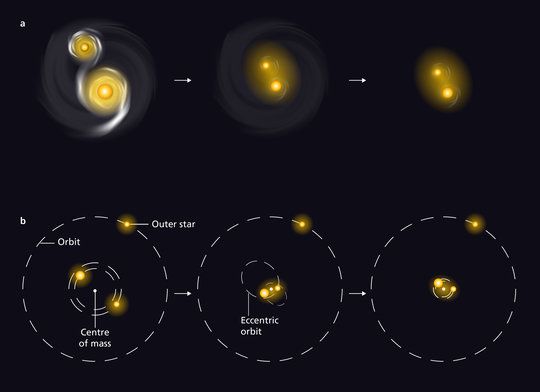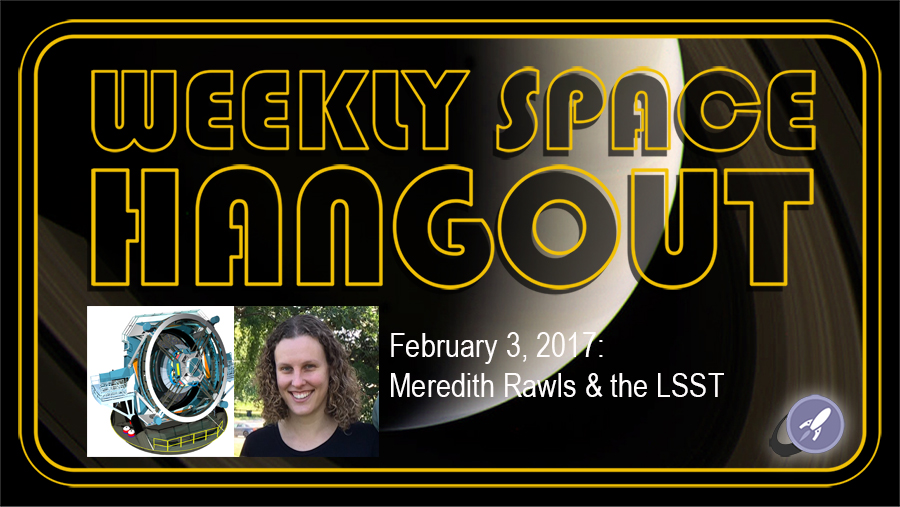Dancing is a favorite pastime of many couples. Swinging around a dance floor, using the laws of physics to twirl at just the right moment, and hopefully not step on any toes, is an art unto itself. The same laws of physics that govern couples on a dance floor also govern (to some extent) the much larger dance of stellar objects. And recently astronomers have started to understand the intricacies of how binary stars dance with each other – turns out it’s not quite as simple as doing the tango.
Continue reading “Massive Binary Stars Huddle Up Surprisingly Quickly”Strange Green Star is the Result of a Merger Between two White Dwarfs
A white dwarf isn’t your typical kind of star. While main sequence stars such as our Sun fuse nuclear material in their cores to keep themselves from collapsing under their own weight, white dwarfs use an effect known as quantum degeneracy. The quantum nature of electrons means that no two electrons can have the same quantum state. When you try to squeeze electrons into the same state, they exert a degeneracy pressure that keeps the white dwarf from collapsing.
Continue reading “Strange Green Star is the Result of a Merger Between two White Dwarfs”Astronomers Measure a 1-billion Tesla Magnetic Field on the Surface of a Neutron Star
We recently observed the strongest magnetic field ever recorded in the Universe. The record-breaking field was discovered at the surface of a neutron star called GRO J1008-57 with a magnetic field strength of approximately 1 BILLION Tesla. For comparison, the Earth’s magnetic field clocks in at about 1/20,000 of a Tesla – tens of trillions of times weaker than you’d experience on this neutron star…and that is a good thing for your general health and wellbeing.
Neutron stars are the “dead cores” of once massive stars which have ended their lives as supernova. These stars exhausted their supply of hydrogen fuel in their core and a power balance between the internal energy of the star surging outward, and the star’s own massive gravity crushing inward, is cataclysmically unbalanced – gravity wins. The star collapses in on itself. The outer layers fall onto the core crushing it into the densest object we know of in the Universe – a neutron star. Even atoms are crushed. Negatively charged electrons are forced into the atomic nuclei meeting their positive proton counterparts creating more neutrons. When the core can be crushed no further, the outer remaining material of the star rebounds back into space in a massive explosion – a supernova. The resulting neutron star, made of the crushed stellar core, is so dense that a single sugar-cube-sized sampling would weigh billions of tons – as much as a mountain (though if you’re “worthy” you MIGHT able to lift it since Thor’s Hammer is made of the stuff). Neutron stars are typically about 20km in diameter and can still be a million degrees Kelvin at the surface.
But if they’re “dead,” how can neutron stars be some of the most magnetic and powerful objects in the Universe?
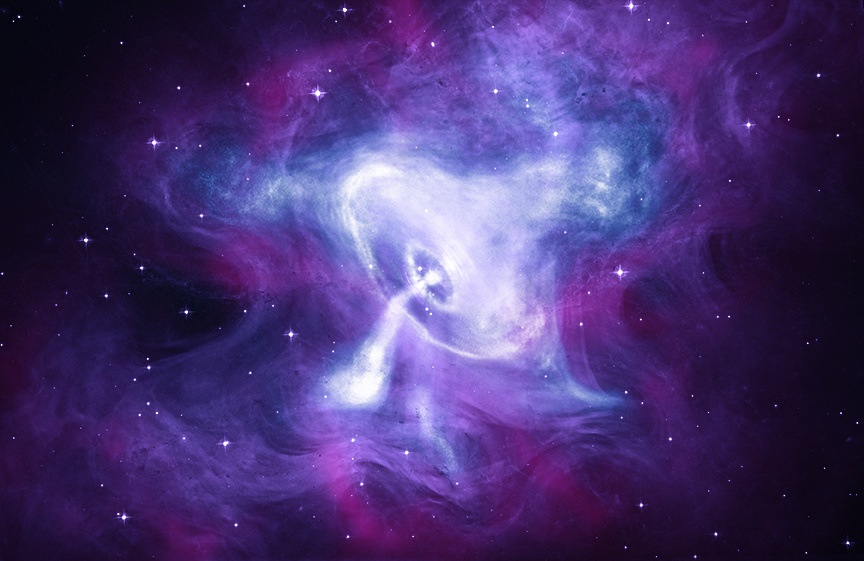
This is a Binary Star in the Process of Formation
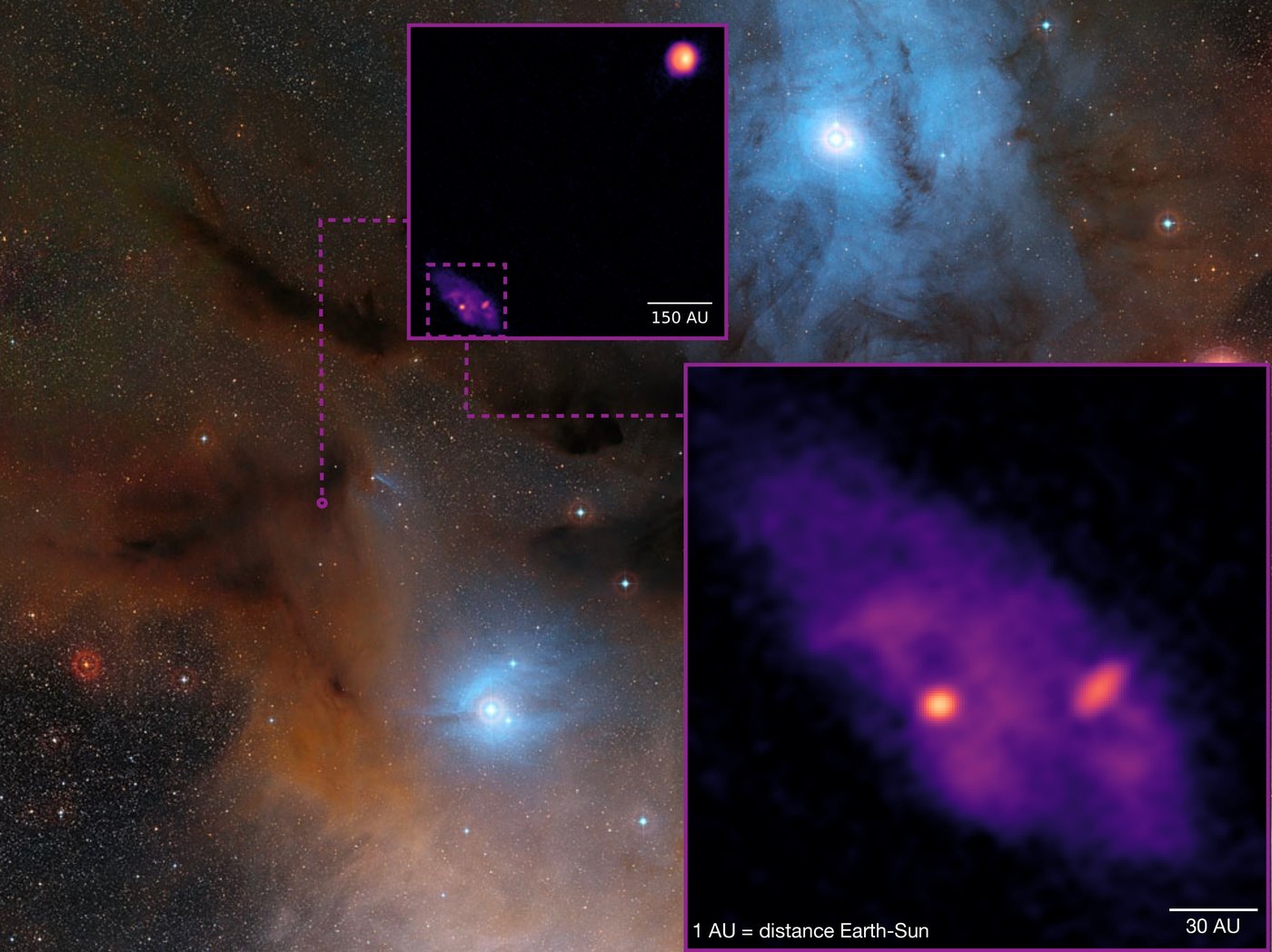
About 460 light years away lies the Rho Ophiuchi cloud complex. It’s a molecular cloud—an active star-forming region—and it’s one of the closest ones. R. Ophiuchi is a dark nebula, a region so thick with dust that the visible light from stars is almost completely obscured.
But scientists working with ALMA have pin-pointed a pair of young proto-stars inside all that dust, doing the busy work of becoming active stars.
Continue reading “This is a Binary Star in the Process of Formation”Much of the Lithium Here on Earth Came from Exploding White Dwarf Stars

The Big Bang produced the Universe’s hydrogen, helium, and a little lithium. Since then, it’s been up to stars (for the most part) to forge the rest of the elements, including the matter that you and I are made of. Stars are the nuclear forges responsible for creating most of the elements. But when it comes to lithium, there’s some uncertainty.
A new study shows where much of the lithium in our Solar System and our galaxy comes from: a type of stellar explosion called classical novae.
Continue reading “Much of the Lithium Here on Earth Came from Exploding White Dwarf Stars”Jupiter is so Big that our Solar System almost had two Suns
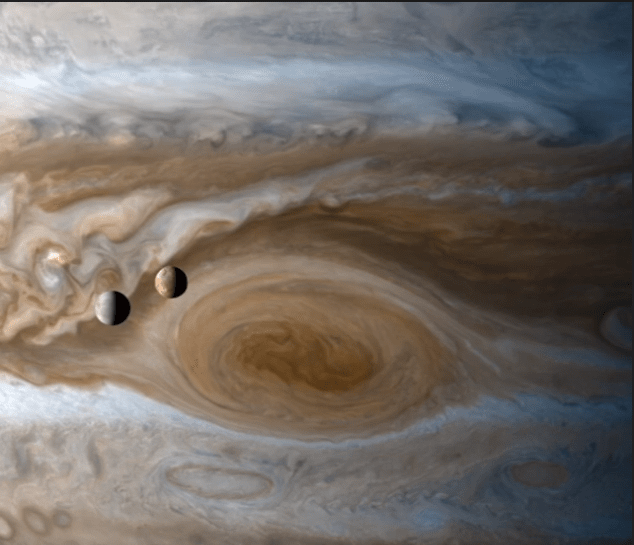
About half of all the star systems in the galaxy are made of pairs or triplets of stars. Our solar system features just one star, the Sun, and a host of (relatively) small planets. But it was almost not the case, and Jupiter got right on the edge of becoming the Sun’s smaller sibling.
Jupiter, the biggest planet in the solar system, is by far the largest. If you added up the masses of all the other planets, it wouldn’t even come to half of the mass of Jupiter. You could eliminate every single planet in the solar system except Jupiter, and you would basically still have…the solar system.
Continue reading “Jupiter is so Big that our Solar System almost had two Suns”Was Betelgeuse Formed by Merging Stars?

Modern humans—or Homo Sapiens—have only been around for about 250,000 years. That’s only the blink of an eye in cosmological terms. As it turns out, the star Betelgeuse may only be about the same age.
A new study explores the idea that Betelgeuse formed from a merger of two stars only a few hundred thousand years ago.
Continue reading “Was Betelgeuse Formed by Merging Stars?”The Most Massive Neutron Star has been Found. It’s ALMOST the Most Massive Neutron Star That’s Even Possible
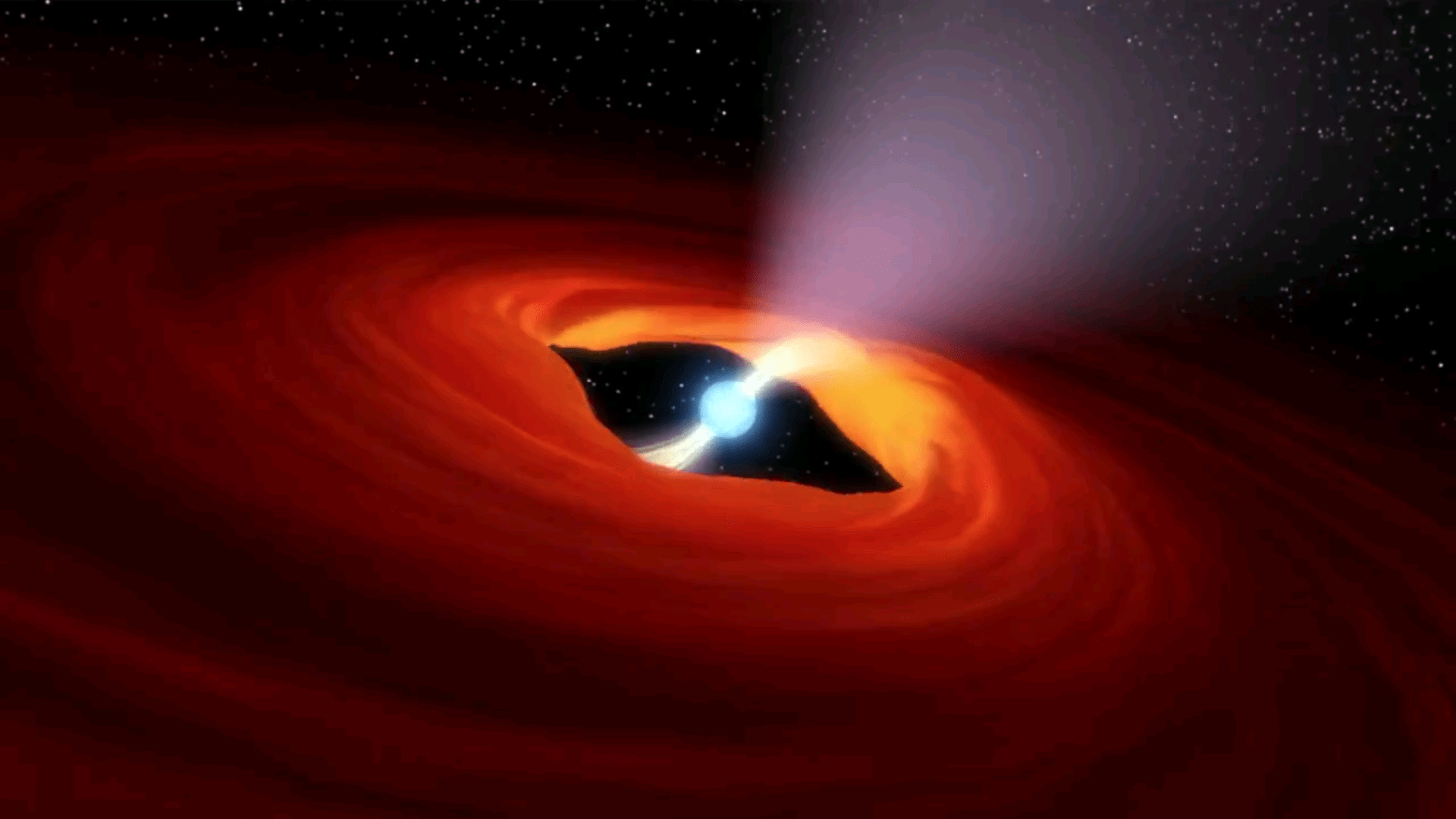
Neutron stars are the end-state of massive stars that have spent their fuel and exploded as supernovae. There’s an upper limit to their mass, because a massive enough star won’t become a neutron star; it’ll become a black hole. But finding that upper mass limit, or tipping point, between a star that becomes a black hole and one that becomes a neutron star, is something astronomers are still working on.
Now a new discovery from astronomers using the National Science Foundation’s (NSF) Green Bank Telescope (GBT) have found the most massive neutron star yet, putting some solid data in place about the so-called tipping point.
Continue reading “The Most Massive Neutron Star has been Found. It’s ALMOST the Most Massive Neutron Star That’s Even Possible”There are Strange Objects Near the Center of the Galaxy. They Look Like Gas, but Behave Like Stars
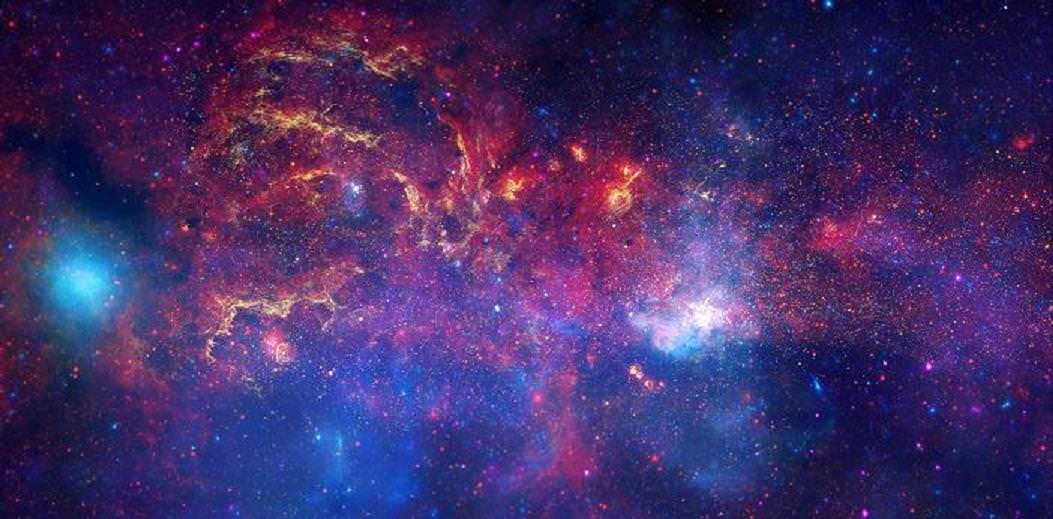
During the 1970s, astronomer became aware of a massive radio source at the center of our galaxy that they later realized was a Supermassive Black Hole (SMBH) – which has since been named Sagittarius A*. And in a recent survey conducted by NASA’s Chandra X-ray Observatory, astronomers discovered evidence for hundreds or even thousands of black holes located in the same vicinity of the Milky Way.
But, as it turns out, the center of our galaxy has more mysteries that are just waiting to be discovered. For instance, a team of astronomers recently detected a number of “mystery objects” that appeared to be moving around the SMBH at Galactic Center. Using 12 years of data taken from the W.M. Keck Observatory in Hawaii, the astronomers found objects that looked like dust clouds but behaved like stars.
The research was conducted through a collaboration between Randy Campbell at the W.M. Keck Observatory, members of the Galactic Center Group at UCLA (Anna Ciurlo, Mark Morris, and Andrea Ghez) and Rainer Schoedel of the Instituto de Astrofisica de Andalucia (CSIC) in Granada, Spain. The results of this study were presented at the 232nd American Astronomical Society Meeting during a press conference titled “The Milky Way & Active Galactic Nuclei”.
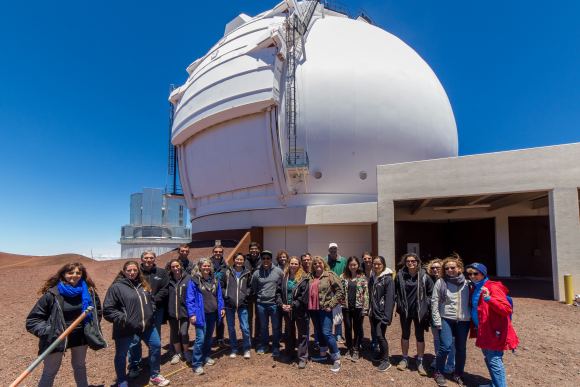
As Ciurlo explained in a recent W.M. Keck press release:
“These compact dusty stellar objects move extremely fast and close to our Galaxy’s supermassive black hole. It is fascinating to watch them move from year to year. How did they get there? And what will they become? They must have an interesting story to tell.”
The researchers made their discovery using 12 years of spectroscopic measurements obtained by the Keck Observatory’s OH-Suppressing Infrared Imaging Spectrograph (OSIRIS). These objects – which were designed as G3, G4, and G5 – were found while examining the gas dynamics of the center of our galaxy, and were distinguished from background emissions because of their movements.
“We started this project thinking that if we looked carefully at the complicated structure of gas and dust near the supermassive black hole, we might detect some subtle changes to the shape and velocity,” explained Randy Campbell. “It was quite surprising to detect several objects that have very distinct movement and characteristics that place them in the G-object class, or dusty stellar objects.”
Astronomers first discovered G-objects in proximity to Sagittarius A* more than a decade ago – G1 was discovered in 2004 and G2 in 2012. Initially, both were thought to be gas clouds until they made their closest approach to the supermassive black hole and survived. Ordinarily, the SMBHs gravitational pull would shred gas clouds apart, but this did not happen with G1 and G2.
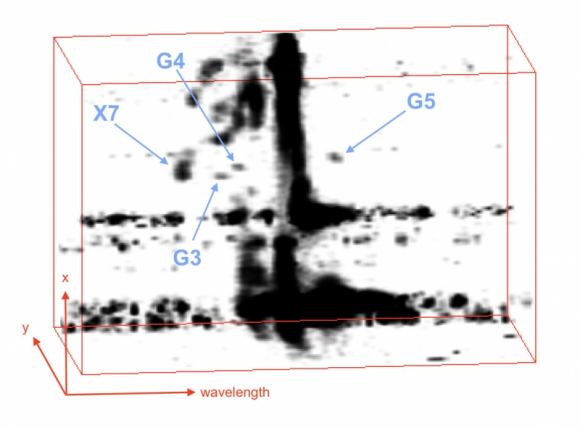
Because these newly discovered infrared sources (G3, G4, and G5) shared the physical characteristics of G1 and G2, the team concluded that they could potentially be G-objects. What makes G-objects unusual is their “puffiness”, where they appear to be cloaked in a layer of dust and gas that makes them difficult to detect. Unlike other stars, astronomers only see a glowing envelope of dust when looking at G-objects.
To see these objects clearly through their obscuring envelope of dust and gas, Campbell developed a tool called the OSIRIS-Volume Display (OsrsVol). As Campbell described it:
“OsrsVol allowed us to isolate these G-objects from the background emission and analyze the spectral data in three dimensions: two spatial dimensions, and the wavelength dimension that provides velocity information. Once we were able to distinguish the objects in a 3-D data cube, we could then track their motion over time relative to the black hole.”
UCLA Astronomy Professor Mark Morris, a co-principal investigator and fellow member of UCLA’s Galactic Center Orbits Initiative (GCOI), was also involved in the study. As he indicated:
“If they were gas clouds, G1 and G2 would not have been able to stay intact. Our view of the G-objects is that they are bloated stars – stars that have become so large that the tidal forces exerted by the central black hole can pull matter off of their stellar atmospheres when the stars get close enough, but have a stellar core with enough mass to remain intact. The question is then, why are they so large?
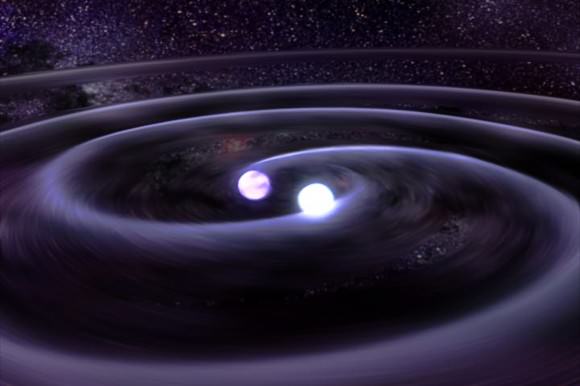
After examining the objects, the team noticed that there was a great deal of energy was emanating from them, more than what would be expected from typical stars. As a result, they theorized that these G-objects are the result of stellar mergers, which occur when two stars that orbit each other (aka. binaries) crash into each other. This would have been caused by the long-term gravitational influence of the SMBH.
The resulting single object would be distended (i.e. swell up) over the course of millions of years before it finally settled down and appeared like a normal-sized star. The combined objects that resulted from these violent mergers could explain where the excess energy came from and why they behave like stars do. As Andrea Ghez, the founder and director of GCOI, explained:
“This is what I find most exciting. If these objects are indeed binary star systems that have been driven to merge through their interaction with the central supermassive black hole, this may provide us with insight into a process which may be responsible for the recently discovered stellar mass black hole mergers that have been detected through gravitational waves.”
Looking ahead, the team plans to continue following the size and shape of the G-objects’ orbits in the hopes of determining how they formed. They will be paying especially close attention when these stellar objects make their closest approach to Sagittarius A*, since this will allow them to further observe their behavior and see if they remain intact (as G1 and G2 did).
This will take a few decades, with G3 making its closest pass in 20 years and G4 and G5 taking decades longer. In the meantime, the team hopes to learn more about these “puffy” star-like objects by following their dynamical evolution using Keck’s OSIRIS instrument. As Ciurlo stated:
“Understanding G-objects can teach us a lot about the Galactic Center’s fascinating and still mysterious environment. There are so many things going on that every localized process can help explain how this extreme, exotic environment works.”
And be sure to check out this video of the presentation, which takes place from 18:30 until 30:20:
Further Reading: Keck Observatory
Weekly Space Hangout – February 3, 2017: Meredith Rawls & the LSST
Host: Fraser Cain (@fcain)
Special Guest: Meredith Rawls
Meredith is a Postdoctoral Researcher in the Department of Astronomy at the University of Washington. She writes software to prepare for the coming onslaught of data from the Large Synoptic Survey Telescope and studies weird binary stars. She is also the lead organizer of the ComSciCon-Pacific Northwest workshop for STEM graduate students in Seattle this March. Meredith holds degrees in physics and astronomy from Harvey Mudd College, San Diego State University, and New Mexico State University. When she’s not science-ing or telling people all about it, she plays viola, volunteers at summer camp, and advocates for more equity and less light pollution.
Guests:
Paul M. Sutter (pmsutter.com / @PaulMattSutter)
Kimberly Cartier ( KimberlyCartier.org / @AstroKimCartier )
Their stories this week:
Oxygen on the moon
Nearby “super-void” shapes galaxy motion
First science from Keck’s vortex coronograph
We use a tool called Trello to submit and vote on stories we would like to see covered each week, and then Fraser will be selecting the stories from there. Here is the link to the Trello WSH page (http://bit.ly/WSHVote), which you can see without logging in. If you’d like to vote, just create a login and help us decide what to cover!
If you would like to join the Weekly Space Hangout Crew, visit their site here and sign up. They’re a great team who can help you join our online discussions!
If you would like to sign up for the AstronomyCast Solar Eclipse Escape, where you can meet Fraser and Pamela, plus WSH Crew and other fans, visit our site linked above and sign up!
We record the Weekly Space Hangout every Friday at 12:00 pm Pacific / 3:00 pm Eastern. You can watch us live on Universe Today, or the Universe Today YouTube page

